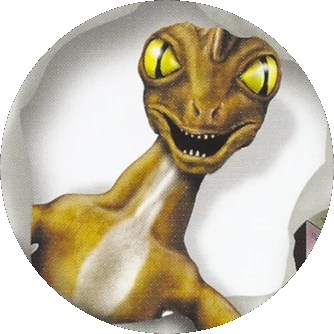Compsognathus has been a mystery dinosaur to scientists since the day they found its fossils. Experts first thought this dino lived an aquatic lifestyle, but now know it was a fast and agile hunter on land. Questions remain about compsognathus (called "compy" for short), such as whether its skin was scaly or feathered, or how many fingers it had with which to grab its prey.
Finger Food: Some think compy had two fingers on each hand, like a mini T-rex, while others think it had three, like most other meat-eating dinos. With three fingers, compy could have grabbed prey, but with two could have only pinned them to the ground.
Lizard Eater: Compsognathus' bird-like beak was lined with small but sharp teeth that crunched up prey, such as insects and small reptiles. The first fossils of this dino ever found contained the remains of a small lizard in the creature's stomach!
A Feathered Fiend?[]

Perfectly preserved fossils clearly show this dino's skeleton, but no one is sure whether it had feathers or scales.
There is a lot of argument among dino experts as to what compsognathus' skin was like. The first specimens found in the 1800s didn't show anything special, so scientists assumed that it had scales, like all other dinos were thought to have had at the time. However, the fossils of one of compsognathus' relatives was found in China in 1996, clearly showing feather imprints in the fossilized rocks around it. Some experts think this means that compy must have had feathers, too, but others still think they need to find direct evidence to say for sure.
Bird Brain: Feathers or no, compsognathus helped convince scientists that some dinosaurs evolved into birds. Compy's fossils were found in the same area with archaeopteryx, the first known bird, and showed some of the same bone structures.
Lakefront Home: All of this creature's fossils have been found near the shores of what were once ancient lakes and inland seas. Compsognathus likely lurked among inland plants and ran toward shore to catch unwary prey taking a drink..
Flipped Out[]
- The first compsognathus fossils appeared to have flipper-like limbs, so scientists thought the dinosaur waded into the waters it lived near and paddled after fish near the surface. It turns out that the "flippers" were actually pieces of fossilized wood.
- When experts finally identified the dinosaur's actual arms, they painted a clearer picture of the creature's life. It ran around on shores, possibly looking a lot like a large chicken, snapping up reptiles and insects in its beak-like jaws.
Trading Card[]
Trivia[]
- The pronunciation section of the card is potentially incorrect, as it leaves out the "g" in the name. Many sources report the name as being pronounced "Comp-SOG-nath-us" instead.
- In the "Lakefront Home" section, the last sentence has two periods at the end.
